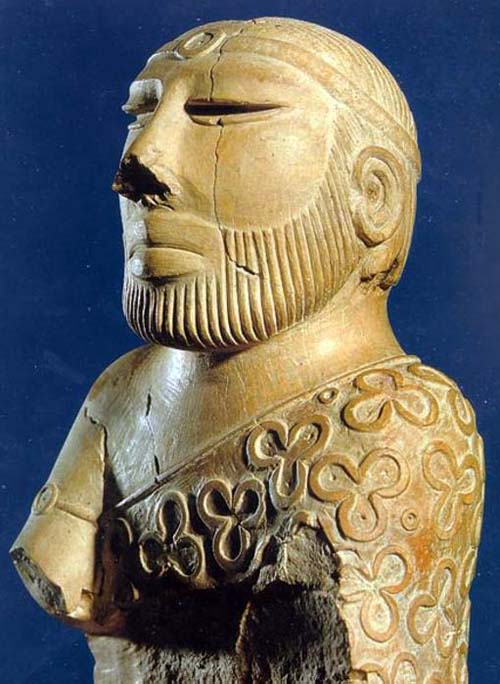
Sculpture of a Priest King, ca. 2500 BC
from the Pakistan National Museum, Karachi
Alexander the Great spread his vast empire south and east from Macedonia until he was stopped at India's Beas River. His last conquest had been the Indus River Valley, which runs the length of present-day Pakistan. But, as Alexander gazed across the Indus Valley 2400 years ago, he had no way of knowing about the great civilization that'd thrived there, 3000 years before him.
The three early urban civilizations were the one in Egypt's Nile Valley, the one along Mesopotamia's Tigris and Euphrates, and this one along the Indus. Settled agriculture was thousands of years old in all three by 3200 BC. Then the cities rose.
The Indus Valley civilization crumbled a thousand years before Alexander — possibly hastened by drought, maybe drawn away by new civilizations rising in India to the east. We rediscovered it only when British rail builders began finding ruins. The ancient cities of Babylon and Memphis were well known by then. But, when at last we found this old world, it was slow to catch our imaginations. We're only just learning about cities like Mohenjo-Daro or Harappa.
 Some 35,000 people lived in the brick houses that made up the orderly planned city of Mohenjo-Daro. They were served by elaborate water distribution and sewage systems. They had a large public bath, colonnades, and a watch-tower system. Mohenjo-Daro was a world-wide trading center — as was the city of Harappa, far up the river to the northeast. Harappa was even larger.
Some 35,000 people lived in the brick houses that made up the orderly planned city of Mohenjo-Daro. They were served by elaborate water distribution and sewage systems. They had a large public bath, colonnades, and a watch-tower system. Mohenjo-Daro was a world-wide trading center — as was the city of Harappa, far up the river to the northeast. Harappa was even larger.
The Indus valley civilization, based on trade, craft, and agriculture, was far more egalitarian than ancient Egypt. Much more of its wealth went into the common good than into glorifying a tiny ruling elite — no Pyramids here. It had some fancy aristocratic housing, but the focus was on urban planning for everyone. Its mercantile economy led to sophisticated weights and measures. Standardized length scales were subdivided down to about a sixteenth of our inch — far more precise than in any other bronze-age society. Weight measurements were refined to a mere ounce.
Indus dentists drilled and crowned teeth; Indus engineers built tidal locks and other sophisticated water management equipment. Indus merchant ships traded with distant Mesopotamia. They were fine metallurgists. Their sculpture was lovely and imaginative; their musicians played a variety of stringed instruments. They had what was probably an ideographic form of writing, something like that later used in Central American cultures.
As we keep learning, we find a world that some compare with the Mycenaeans: tradesmen & artisans, farmers & sailors — a world so different from Alexander's. His raiding armies were a mere flicker as they passed through this region — long after these peaceful old cities had vanished and been forgotten.

Aerial view of the lower Indus valley

Estimated extent of the Indus Valley Civilization

Harappan Terra Cotta
Sources:
A. Lawler, Boring No More, a Trade-Savvy Indus Emerges. Science, Vol. 320, 6 June, 2008. pp. 1276-1285.
See also the Wikipedia articles on The Indus Valley, on Harappa and on Mohenjo-Daro. Here are the site web pages for Harappa and Mohenjo-Daro.
Images: Aerial views courtesy of Google Earth. Priest-King sculpture, toy, terra cotta sculptures, and Indus Valley map courtesy of Wikipedia Commons.

Arial view of the Mohenjo-Daro site